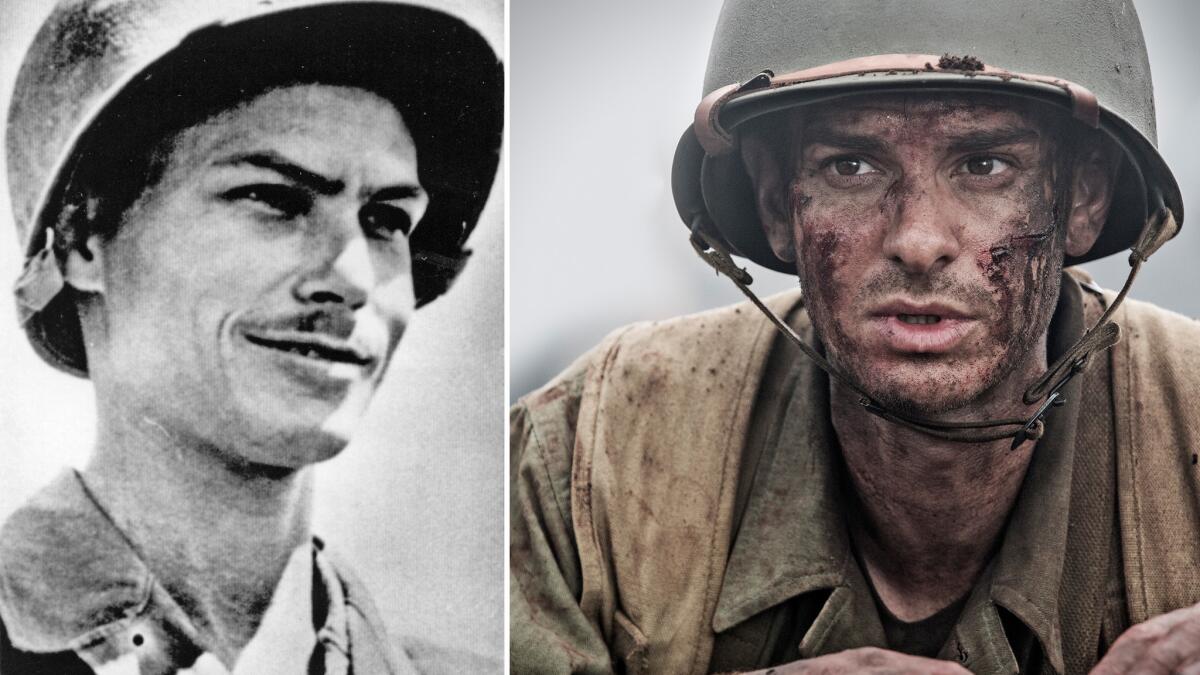From ‘Sully’ to ‘Hidden Figures,’ biopics are featuring appearances from their real-life subjects
For a number of reasons, straight biopics and even films simply based on actual events have taken to playing up the real-life people behind their stories this season.
Consider “Sully” and “Snowden,” “Hidden Figures” and “Hacksaw Ridge,” “Lion” and “Loving” — it has become de rigueur to feature, often just before the end credits, a photo, old video or filmed appearance of the people the movie has just spent the last two or so hours dramatizing.
And each set of directors, producers and writers have their own reasoning behind the device. Sure, when run with the credits it’s an optimal way to get the audience to stay in their seats — but there’s more to it than that. Showing the real people involved can add to the emotional effect of a story, prove the hero or events on-screen were not made up, even provide a de facto endorsement of the movie.
And sometimes, showing the real deal can be as dramatic as the Hollywood story: Imagine making a film about a lost boy raised in a different home — and then having actual footage of him with his adoptive and biological moms in real life?

Dev Patel talks about portraying a man raised in Australia, then tracing his roots in India in “Lion.”
Such was the case with “Lion,” notes producer Angie Fielder, who says that using that footage of the young man recently reunited with his birth mother in India has a huge effect with viewers. “Some audience members have commented that seeing this footage was almost cathartic,” she says. “As I’m sure the experience was cathartic for Saroo and his mothers.”
Many of the films feature individuals who did something heroic or extraordinary, and filmmakers seem to have a need to provide real-life proof that the individual did or does exist. “This was part of the storytelling for me,” says “Hacksaw Ridge” producer Bill Mechanic. “Nobody in real life could lift 75 people and haul them hundreds of yards to safety [as movie subject Desmond Doss did] with hundreds of Japanese soldiers targeting them over a 10-hour period. But he did. It’s so far above and beyond anything I’ve ever read I thought there was a need to make sure people realized it was true.”

Showing the real people behind the heroes also humanizes them, suggests “Sully” producer Allyn Stewart. “For me, it’s a narrative where at the end of the movie you’re reminded, ‘Hey, this person really exists, he’s not Iron Man. He’s a real guy.’”
“Audiences actually applaud as the cast comes out for a final bow,” says John Carls, producer of “Queen of Katwe,” which features the actor and the real-life person he or she is portraying coming on-screen together with an update of what the real person is doing now. “This is a very present story, and maybe it adds additional weight to the experience the audience just had — seeing the real people makes it more emotionally compelling.”
And in some cases, it’s about reminding the audience that the story isn’t made up even if you haven’t heard of, say, Edward Snowden. “I lived in Texas for the last seven years, and virtually no one I spoke to in the first few months after ‘Snowden’ came out knew he wasn’t WikiLeaks,” says Kieran Fitzgerald, who co-wrote “Snowden” with director Oliver Stone. “Just reminding people that this is a real guy benefits the film and Edward Snowden himself. And then you have the understanding that what you’ve just seen has probably been endorsed by this real guy and is more likely to be accurate.”
Even so, not every real-life film warrants a reminder of the person who inspired it. “It’s on a film-by-film basis,” says Ted Melfi, director of “Hidden Figures,” about the real-life African American women who helped NASA get ahead in the space race. “A film about JFK or Ray Charles or Elvis — someone really well known in the public lexicon … I would not feel compelled to put their pictures at the end of the film. It’s unnecessary.”
And even if audiences don’t find such appearances emotionally edifying, it’s undoubtedly a charge for the real folks involved.
“When we filmed on the docks [of the Hudson River] for the rescue scenes, all the Red Cross people [from the original incident] showed up — and it wasn’t because they wanted [director] Clint Eastwood’s autograph,” says Stewart. “They felt proud of their success, so they wanted to be a part of the film. I’m very moved by it. What you see in them at the end, that’s real pride.”
See the most read stories this hour »
More to Read
From the Oscars to the Emmys.
Get the Envelope newsletter for exclusive awards season coverage, behind-the-scenes stories from the Envelope podcast and columnist Glenn Whipp’s must-read analysis.
You may occasionally receive promotional content from the Los Angeles Times.










